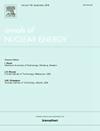Assessment of nuclear desalination in a small modular reactor using membrane distillation
IF 1.9
3区 工程技术
Q1 NUCLEAR SCIENCE & TECHNOLOGY
引用次数: 0
Abstract
Despite the proven feasibility and cost-effectiveness of nuclear desalination in small modular reactors (SMRs), the exclusive use of waste heat for this purpose remains virtually unexplored. This work investigates coupling an SMR (NuScale) to a direct contact membrane distillation (DCMD) desalination plant with heat recovery and feed recycle. Both the reactor waste heat and the low-pressure (LP) steam extraction from the reactor turbine were considered as heat sources. The DCMD hollow fiber module was modeled as a porous medium with satisfactory accuracy. Key parameters affecting system performance, identified through factorial analysis, include membrane porosity, module length, feed superficial velocity, and fiber inner radius. Single and multiobjective optimization analyses revealed the feasibility of producing up to 3,810 m3/d of water without any reactor power loss, and up to 8,832 m3/d, with a 2.28 MWe power loss, using steam extraction. DCMD demonstrated competitiveness, especially when the reactor’s primary purpose is electricity generation.

求助全文
约1分钟内获得全文
求助全文
来源期刊

Annals of Nuclear Energy
工程技术-核科学技术
CiteScore
4.30
自引率
21.10%
发文量
632
审稿时长
7.3 months
期刊介绍:
Annals of Nuclear Energy provides an international medium for the communication of original research, ideas and developments in all areas of the field of nuclear energy science and technology. Its scope embraces nuclear fuel reserves, fuel cycles and cost, materials, processing, system and component technology (fission only), design and optimization, direct conversion of nuclear energy sources, environmental control, reactor physics, heat transfer and fluid dynamics, structural analysis, fuel management, future developments, nuclear fuel and safety, nuclear aerosol, neutron physics, computer technology (both software and hardware), risk assessment, radioactive waste disposal and reactor thermal hydraulics. Papers submitted to Annals need to demonstrate a clear link to nuclear power generation/nuclear engineering. Papers which deal with pure nuclear physics, pure health physics, imaging, or attenuation and shielding properties of concretes and various geological materials are not within the scope of the journal. Also, papers that deal with policy or economics are not within the scope of the journal.
 求助内容:
求助内容: 应助结果提醒方式:
应助结果提醒方式:


